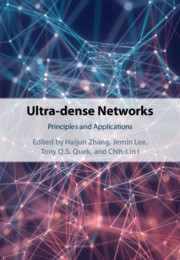Book contents
- Frontmatter
- Contents
- List of Contributors
- Part I Overview
- Part II Physical Layer Design
- 3 NOMA-Based Ultra-dense Networks
- 4 Physical Layer Security in Ultra-dense Networks
- 5 Millimeter-Wave Multiantenna Ultra-dense Networks
- 6 Interference Management in Ultra-dense Networks
- 7 3D-Based Base Station Deployment in Ultra-dense Networks
- 8 Power Control in Full-duplex Ultra-dense Heterogeneous Networks
- Part III Resource Allocation and Network Management
- Part IV Field Trials and Tests
- Index
8 - Power Control in Full-duplex Ultra-dense Heterogeneous Networks
from Part II - Physical Layer Design
Published online by Cambridge University Press: 12 October 2020
- Frontmatter
- Contents
- List of Contributors
- Part I Overview
- Part II Physical Layer Design
- 3 NOMA-Based Ultra-dense Networks
- 4 Physical Layer Security in Ultra-dense Networks
- 5 Millimeter-Wave Multiantenna Ultra-dense Networks
- 6 Interference Management in Ultra-dense Networks
- 7 3D-Based Base Station Deployment in Ultra-dense Networks
- 8 Power Control in Full-duplex Ultra-dense Heterogeneous Networks
- Part III Resource Allocation and Network Management
- Part IV Field Trials and Tests
- Index
Summary
Full duplex ultra-dense network (FDUDN) is envisioned as a promising network paradigm for spectrum efficiency enhancement. This chapter presents a power management scheme, which maximizes the total capacity of FDUDN, under given Quality-of-Service (QoS) and cross-tier interference constraints. The inter-cell power control is formulated as a non-convex optimization problem and the variable substitution is used to transform it into a convex one. Furthermore, the problem is solved through a low-complexity heuristic scheme, which utilizes the water-filling theorem in inter-cell power allocation. Simulation demonstrates the enhancement effect of the proposed scheme in terms of the capacity and the power efficiency.
Information
- Type
- Chapter
- Information
- Ultra-dense NetworksPrinciples and Applications, pp. 127 - 140Publisher: Cambridge University PressPrint publication year: 2020
